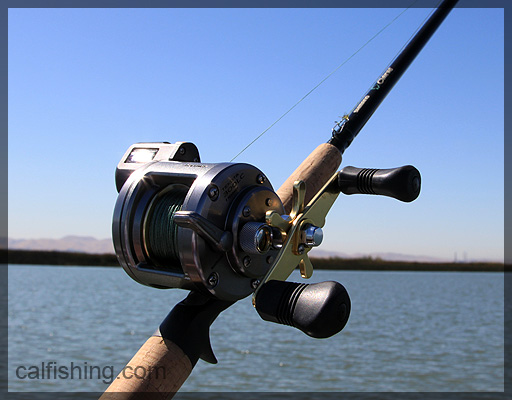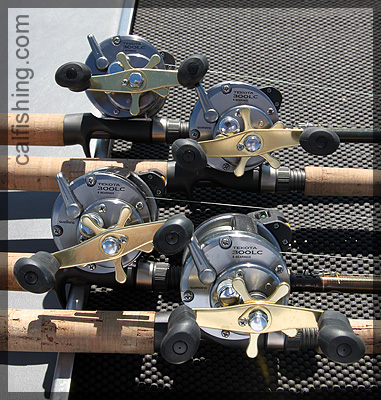|
Like every type of fishing, it is necessary to match the lures being used to a rod with the proper action. There are two important characteristics when it comes to choosing a trolling rod. First, the rod needs to have a good back bone. The rod should control the fish during the battle and not the other way around. While trolling for Stripers, there is always the chance that one can go head-to-head with a fish in the 20 to 30 pound range or even pushing the 40 or 50 pound range in extremely rare cases. Being prepared and having a rod with a back bone will be advantageous. The second characteristic is to have a rod tip that will telegraph the action of the lure while it is swimming through the water. As a general rule of thumb, any rods that measure 7’ to 7’6” in length and medium to medium-heavy power with moderate fast to fast action tips will make great trolling rods.
From personal experience, I prefer using a CSC-70MHA Shimano Clarus. It is constructed with IM-7 graphite blank construction and has medium-heavy power with a fast action tip. It is rated for ¼ oz to 1 oz. lures. I have caught many Stripers pushing the 20 pound mark, and this rod has enough backbone power to handle those trophies. It also has a very responsive tip to the point where I can detect the slightest blade of grass or weeds on my lure while trolling. Another plus is the price of the rod. Priced at $79.99, I think it is one of the best valued rods out there.

While choosing the proper rod action is important when trolling, choosing an appropriate reel is just as important. There are four five factors that I look for in a reel for Striper trolling. The first is the gear ratio. Stripers can be absolute beasts when it comes to fighting one on the end of your line. In order to have proper control of the fish, one should have a low gear ratio for torque rather than speed. I preferably like a reel that has something similar to a 5.1 to 1 gear ratio. The second factor when choosing a Striper trolling reel is a smooth drag. A smooth drag is required because the fight from Stripers will surely test your drag they take many strong runs when hooked. Having a smooth drag will help the fish stay hooked instead of losing what potentially may be a fish of a lifetime. A clicker, or sometimes known as a line alarm, is third factor that I look for in a trolling reel. When a Striper hits on the troll, there’s nothing more exhilarating than hearing the clicker scream letting you know that there’s a fish on. Having a clicker isn’t necessary, but it is something that I cannot do without. The next factor is a line counter. The purpose of the line counter is to obviously let you know how much line you have out. This is important when trolling because it will enable you to have an idea how deep your lure is running. This will be discussed in more depth in a later section. Some reels have built-in line counters. However, there are also those line counters that attach to the rod. I prefer the reels that already come with line counters as I feel that they are more accurate than the ones that attached to the rod. This is just my personal preference however, and both methods will work fine. The last, and final, factor that I consider in a reel is line capacity. Larger Stripers when initially hooked trolling can take an upwards of 200 feet of line at times. Thus, line capacity is a must. As a general rule of thumb, and reel that can hold an upwards of 200 yards of line will suffice. As for the type of line to use, this will be covered in the next section.
A few examples of conventional reels that can be used for trolling are the Abu Garcia Ambassadeur 6500 or the Shimano Calcutta 400B. Both reels have a large amount of line capacity, a gear ratio to produce more torque compared to a high speed reel, they both have loud clickers, and they both have smooth drags. As for line counter reels, there are plenty of options with their Sealine and Accudepth Plus series. The smaller 17 and 27 series reels are more popular among Striper trollers.

However, if I had to choose one reel to recommend for Striper trolling, it would have to be the Shimano Tekota 300LC. This is a great reel for trolling. Its Dartanium drag system is superb when doing battle with a hard fighting Striper, it has enough line capacity where you don’t have to worry about getting spooled by a fish, it has a nice loud clicker, and it also has a line counter already installed on the reel.
There are many options to choose from when it comes to fishing line whether it is braid, monofilament, or fluorocarbon. Each of these lines are advantageous to certain fishing techniques when properly used. Fluorocarbon is not necessary as Striper trolling does not need the increased sensitivity as it is not finesse fishing like when bass fishing. Braided line as your main line is highly recommended when trolling for Stripers for many reasons. For one, the smaller diameter line will in turn reduce water resistance and allow the lures being used to run a little deeper when compared to the same pound test rating in monofilament. Secondly, braided line allows the action of the lure to be telegraphed to the rod tip, which helps you as an angler ensure that the lure is working properly. There are a plethora of braided lines available such as PowerPro, Tuf Line, Stren, etc. My personal preference is 30 lb. test PowerPro. Some elect to go with 50 lb. or even 65 lb. test, but I personally think that 30 lb. test does the job just fine. I have never had any break-offs using it.
Now you may be thinking where does monofilament line come into the realm of Striper trolling? Well, for starters, when using braided line and with its smaller diameter, more line could be fit onto a reel. That is true, but braided line is expensive and no one wants to spend $80 on line to fill only one reel. This is where we can use monofilament. It can be used as backing on your reel. It does not need to be new line. It can be line sitting around the house for years that needs to be gone. For example, on my Shimano Tekota 300LCs, I will use about 200 feet of old 30 lb. Stren monofilament that I have lying around the house, and then tie using a uni knot my 30 lb. PowerPro to it. Be sure to put at least 150 yards of braid on your reel.
The second use for monofilament is for leaders between the braided line and the lure. If you think about the properties of braid, it does not stretch at all, which is not good. In order to solve this problem, monofilament is used to create shock leaders since monofilament stretches. I typically make up 48 inch leaders out of 25 lb. test Maxima Ultragreen or P-Line CXX monofilament line. These shock leaders will provide some stretch when the initial hit happens and also during the fight. This is also why a reel with a good drag is required. I use a barrel swivel and tie the braided line to one end of it and the monofilament leader to the other end with Palomar knots. At the end of the leader, I tie a duo lock snap with a Palomar knot as well.
|
